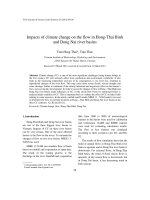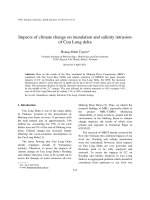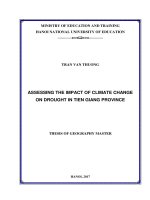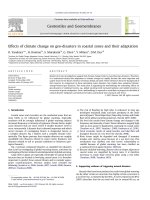Effect of climate change on cropping pattern of vegetables in Madhya Pradesh, India
Bạn đang xem bản rút gọn của tài liệu. Xem và tải ngay bản đầy đủ của tài liệu tại đây (278.54 KB, 9 trang )
Int.J.Curr.Microbiol.App.Sci (2019) 8(4): 1350-1358
International Journal of Current Microbiology and Applied Sciences
ISSN: 2319-7706 Volume 8 Number 04 (2019)
Journal homepage:
Original Research Article
/>
Effect of Climate Change on Cropping Pattern of Vegetables in
Madhya Pradesh, India
Shobha Sanodiya1, Kinjulck C. Singh2, Varsha Shrivastava3* and Chandrajit Singh2
1
Department of Extension Education, 2KVK, Rewa, JNKVV, Jabalpur, M.P., India
3
ATARI, Jabalpur, M.P., India
*Corresponding author
ABSTRACT
Keywords
Socio-economic
status, Climate
change, Cropping
pattern, Vegetable
cultivation
Article Info
Accepted:
12 March 2019
Available Online:
10 April 2019
The study was carried out in seoni district of Madhya Pradesh to assess the effect of
Climate change on cropping pattern of vegetables. Six villages of Seoni block were
selected on the basis maximum area under vegetable crops. Total 120 vegetable growers
were selected by simple random sampling method. The study reveals that more than half of
the vegetable growers had medium socio-economic status and half of the vegetable
growers had low level of knowledge towards climate change. Near to two third of the
growers shifted their cropping pattern from potato- Cabbage - cucumber to Maize - Pea Musk melon due to climate change. The results of correlation analysis shows that
occupation and knowledge level of the vegetable growers had positive and significant
correlation with effect of climate change on cropping pattern of vegetables. The vegetable
growers faced economic, market related, technical, situational, extension and institutional
related problems in vegetable cultivation. Planners and development workers should
formulate policies to improve the knowledge towards the climate and design a procedure
to overcome these problems.
Introduction
Vegetables play a vital role in the
maintenance of human health and cheapest
sources of natural protective food,
contributing carbohydrates, vitamins and
minerals in human diet (Choudhury, 2006). A
balanced diet is essential to sustain good
health. For a well-balanced diet, about 300
gram vegetables are required containing root
vegetable, green vegetables and others
vegetables, but only 130 grams per capita is
available. Most of the leafy vegetables and
root crops are rich in minerals like Ca, Fe, and
phosphorous some leafy vegetables are rich in
microelements like copper, manganese zinc
and vitamin A, B, C. In the vegetable
production climate plays a major role and
now a day's climate change is rapidly
affecting the vegetable production.
Climate change is a statistical variation in
properties of the climate system that include
in global temperature, rainfall, sunlight,
1350
Int.J.Curr.Microbiol.App.Sci (2019) 8(4): 1350-1358
precipitation etc. due to human and natural
drivers activity. Agriculture production
depends on environmental, varietal and
management factors. Climate plays a major
role as its positive and negative impact
immediately influences crop productivity.
Awareness among the farmers about the
climate change is very necessary for crop
output in terms of production.
For proper growth and development, all
vegetable requires an optimum temperature
which varies from crop to crop and also limits
the range and production of many crops and
high temperature with low precipitation will
reduced the availability of irrigation water
and
at
the
same
time
increased
evapotranspiration leads to severe water stress
resulting low yield and quality of vegetable
crops (Devi, 2017). A little change in the
climatic parameters will bring drastic changes
in the quality and nutritional value of
vegetables and also affect the post harvest
quality and basis for severe losses and affect
food safety during storage. (Cotty and JaimeGarcia, 2007). Besides these losses also
affects insect pest and disease incidence and
weed infestation in vegetable crops
(Vermeulen et al., 2010). In this view climate
factors affects the vegetable production.
Farmer’s knowledge about the climate is
more important to mitigate the ill effect of
weather or climate to some extent. In the
recent years extreme weather events like
excessive and deficit rainfall, flood, severe
frost, temperature and drought are occurring
more commonly affecting agricultural
production and productivity which leads to
decrease farmer’s income (Bhan et al., 2014).
A lower agricultural production and
productivity due to climate change has
implication for food prices, which in turn
affect the livelihood and food security status
of household in a country. Under this
circumstances improved and sustainable
agriculture technology according to forecast
based, agro advisories and full information
about factor effecting of climate change are
more useful to reduce vulnerability and
improve adaptability of agriculture to climate
change. In Seoni district of Madhya Pradesh
major vegetable crops grown are Tomato,
Onion, Brinjal, Chili, Cucurbits. In a
vegetable growing area of a Seoni many
factor are available which directly connected
with climate change and like average
temperature increase, change in rainfall
amount and pattern, change in climatic
variability and extreme events, weed, pest and
pathogen. Keeping in view of the above
points, the present study was carried out with
following objectives:
To know the personal, socio-economic and
psychological profile of vegetable growers.
To study effect of climate change on cropping
pattern of vegetable crops.
To identify the various problems faced by
vegetable growers.
Materials and Methods
The present study was conducted in Seoni
district of Madhya Pradesh. The Seoni district
is located in the southern part of Madhya
Pradesh. The district lies between latitude 21˚
36’ to 22˚ 57’ North and longitude 79˚ 19’ to
80˚ 17’ East. Out of the 8 blocks, only Seoni
block was selected purposively because it has
the second position of the vegetable
production and area. The block comprises of
289 villages. A list of vegetable crops
growing in the villages were prepared on the
basis of their production, out of which 6
villages Mungwani khurd, Mungwani kala,
Simariya, Khairy, Singhodi and Jamuniya
were selected randomly on the basis of
availability of vegetable growers and adopted
by KVK Seoni. A list of vegetable growers
from selected villages was prepared with the
help of RAEOs. To make sample of 120
1351
Int.J.Curr.Microbiol.App.Sci (2019) 8(4): 1350-1358
respondents for the present study the 20.00
per cent vegetable growers from the total
farmer in selected villages of Seoni block
through proportionate random sampling
method. A well structured and pre tested
schedule was used to collect information from
the vegetable growers.
Results and Discussion
Personal and Socio economic status of the
vegetable growers
The perusal of data presented in table 1
indicates that out of the total vegetable
growers, majority (65.00%) of growers
belonged to middle age group. The result is
consonance with the findings of Pyasi, 2009
and Natya, 2011. A sizable group of the
farmers (44.16%) were educated up to higher
secondary level and 20.00 per cent were
educated up to high school level, while 18.34
per cent were illiterate and only 17.50 per
cent educated up to college level. It was also
noted that majority of growers (72.50%) were
engaged in vegetable cultivation. A sizable
group of vegetable growers (46.67%) had
marginal size of land holding followed by
36.67 per cent small size of land holding,
15.83 per cent had medium size land holding
and very few (0.83 %) had large size of land
holding.
Majority of the growers (60.83%) were found
in low income category followed by medium
income group (28.33%) and high income
group (10.84%). Similar trend was observed
in the study of Neerja et al., (2016). Majority
of the vegetable growers (62.50%) had
medium farm power followed by 20.83 per
cent had low farm power and 16.67 per cent
had high farm power. The percentage of area
under vegetable crops shows the area under
vegetable cultivation in their total land
holding. Majority of the growers (63.34%)
had 1-25 percent area under vegetable crops.
Near to one forth vegetable growers (23.33%)
had 26-50 per cent area and 13.33 per cent
had 51-75 percent area under vegetable crops.
It can be also furnished from that majority of
the vegetable growers (63.33%) had 6-10
tonne production, while 20 per cent had 1-5
tonne production and 16.67 per cent had
above 10 tonne production of vegetable
annually. Near to three fourth growers
(74.17%) had medium farming experience,
while 18.33 per cent had high farming
experience and few farmers (7.50%) had low
farming experience.
Out of the total vegetable growers, 52.50 per
cent had medium socio-economic status while
37.50 per cent had low socio-economic status,
whereas 10.00 per cent had high socioeconomic status.
Psychological variables
The data presented in table 2 revealed that out
of the total vegetable growers, more than half
of the growers (57.50%) were belonged to
medium level of scientific orientation
followed by 27.50 per cent had high scientific
orientation and 15.00 per cent had low
scientific orientation towards vegetable
cultivation. Majority of the growers (66.67%)
had medium risk bearing ability, 18.33 per
cent had high risk bearing ability and 15.00
per cent had low risk bearing ability towards
the vegetable cultivation. Out of the total
vegetable growers, 63.33 per cent had
medium economic motivation, 26.67 per cent
had high economic motivation and 10.00 per
cent had low economic motivation towards
vegetable cultivation.
Knowledge level towards climate change
Knowledge plays a vital role in adoption of
technology. Knowledge towards climate
change will help the farmers in managing
1352
Int.J.Curr.Microbiol.App.Sci (2019) 8(4): 1350-1358
vegetable cultivation practices in phase of
disruptive climatic events. Half of the farmers
(50.00%) had low level of knowledge towards
change in rainfall pattern and rainfall
distribution, while 40.00 per cent had medium
and only 10.00 per cent vegetable growers
had high level of knowledge towards change
in rainfall pattern and rainfall distribution on
vegetable cultivation. Similarly higher
percentage of the vegetable growers (56.67%)
had low level of knowledge followed by
23.33 per cent had medium and 20.00 per cent
had high level of knowledge towards change
in temperature (Table 3).
Out of total vegetable growers, 50.00 per cent
had low knowledge level towards climate
change in concern of vegetable production,
whereas 44.17 per cent had medium
knowledge level and very few vegetable
growers (5.83%) had high knowledge level of
knowledge related to climate change
Effect of climate change on cropping
pattern of vegetable crops
Out of the total vegetable growers, 62.50 per
cent farmers shifted from old cropping pattern
Potato - Cabbage - cucumber to new cropping
pattern Maize - Pea - Musk Melon due to
climate change followed by those vegetable
growers (25.00%) who shifted from old
cropping pattern Okra - Pea - Tomato to new
cropping pattern Pulses - Tomato - cabbage.
Rest of the vegetable growers (12.50%)
shifted from Bitter gourd - Garlic - Pea to
Maize - French bean - Colocasia due to
climate change.
Zero order correlation coefficient between
independent variables and the effect of
climate change on cropping pattern of
vegetable crops revealed that the effect of
climate change on cropping pattern of
vegetable crops had positive and significant
relationship with occupation at 0.01 level of
probability and knowledge level at 0.05 level
of probability (Table 6).
In case of age, farm power, annual
production, and economic motivation of
vegetable growers were found to have
positive and non-significant correlation with
effect of climate change on cropping pattern
of vegetable crop whereas education, size of
land holding, percentage area under vegetable
crop, socio-economic status, annual income,
farming experience, scientific orientation, risk
bearing ability, showed negative and nonsignificant correlation with effect of climate
change on cropping pattern of vegetable crop.
Problems faced by vegetable growers
The problems reported by the growers in
production of vegetable crops were lack of
fund to purchase agriculture input (93.33%) is
the first economic problem, the second and
third problems were highest cost of fertilizer,
seed, equipment and pesticide (81.67%) and
high labour cost (77.50%). The fourth
problem was lack of loan facility (68.33%). In
case of the market related problem low price
of vegetable in market (84.17%) received first
rank followed by lack of knowledge of market
price of vegetable (75.83%) with second rank,
irregularity of market facility (77.50%)
ranked third and timely unavailability of
fertilizer, seed and insecticide etc. in market
(75.00%) received forth rank (Table 5).
It is also furnished that Lack of knowledge of
high production variety (75.83%) was first
technical problem, followed by training
related problem (75.00%), lack of soil testing
facility (74.17%), lack of knowledge about
quantity and medicine for seed treatment
(71.67%) and lack of knowledge of pest and
disease were technical problems in vegetable
cultivation. Similar study has been done by
Sahu et al., (2013).
1353
Int.J.Curr.Microbiol.App.Sci (2019) 8(4): 1350-1358
Table.1 Personal and socio-economic status of the vegetable growers
N=120
Categories
Age
Young age group
Middle age group
Old age group
Education
Illiterate
Up to high school
Up to higher secondary
Up to College
Occupation
Vegetable Cultivation
Vegetable Cultivation + labour
Vegetable Cultivation + business
Vegetable Cultivation + service
Size of Land Holding
Marginal farmer
Small farmer
Medium farmer
Large farmer
Annual income
Low
Medium
High
Farm power
Low
Medium
High
Percentage of area under vegetable crops
(1-25 %) area
(26-50%) area
(51-75 %) area
Annual production of vegetable crops
1-5 tonne
6-10 tonne
Above 10 tonne
Farming experience
Low
Medium
High
Socio economic status
Low
Medium
High
1354
Frequency
Percentage
26
78
16
21.66
65.00
13.34
22
24
53
21
18.34
20.00
44.16
17.50
87
15
10
8
72.50
12.50
8.33
6.67
56
44
19
01
46.67
36.67
15.83
0.83
73
34
13
60.83
28.33
10.84
25
75
20
20.83
62.50
16.67
76
63.34
28
16
23.33
13.33
24
76
20
20.00
63.33
16.67
09
89
22
07.50
74.17
18.33
45
63
12
37.50
52.50
10.00
Int.J.Curr.Microbiol.App.Sci (2019) 8(4): 1350-1358
Table.2 Psychological variables of vegetable growers
Categories
Scientific orientation
Low
Medium
High
Risk bearing ability
Low
Medium
High
Economic motivation
Low
Medium
High
Frequency
N= 120
Percentage
18
69
33
15.00
57.50
27.50
18
80
22
15.00
66.67
18.33
12
76
32
10.00
63.33
26.67
Table.3 Knowledge level towards the impact of climate change on vegetable crops
N= 120
Knowledge level towards change in rainfall pattern and rainfall distribution
Categories
Frequency
Percentage
60
Low
50.00
48
Medium
40.00
12
High
10.00
Knowledge level towards change in temperature
68
Low
56.67
28
Medium
23.33
24
High
20.00
Knowledge level towards climate change
Low
60
50.00
Medium
53
44.17
High
7
5.83
Table.4 Effect of climate change on cropping pattern of vegetable crops
Old cropping pattern
Potato
Cabbage
cucumber
Okra - Pea – Tomato
Bitter guard - Garlic – Pea
New cropping pattern
Maize - Pea - Musk melon
Pulses - Tomato - cabbage
Maize - French bean –
Colocasia
Total
1355
Frequency
75
Percentage
62.50
30
15
25.00
12.50
120
100.00
Int.J.Curr.Microbiol.App.Sci (2019) 8(4): 1350-1358
Table.5 Problems faced by vegetable growers in vegetable cultivation
S.
No.
1.
2.
3.
4.
1.
2.
3.
4.
1
2.
3.
4.
5.
1.
2.
3.
4.
1.
2.
3.
4.
5.
1.
2.
3.
Problems
Frequency
Economic problem
Lack of fund to purchase agriculture input
High cost of fertilizer, seed, equipment and
pesticide.
High labour cost
Lack of loan facility
Market related problem
Lack of knowledge of Market price of
vegetable.
Irregularity of market facility
Timely unavailability of fertilizer, seed and
insecticide etc. in market
Low price of vegetable in market
Technical problem
Lack of knowledge of high production
variety
Lack of knowledge about quantity and
medicine for seed treatment
Training related problem
Lack of knowledge of pest and disease
Lack of soil testing facility
Situational problem
Unavailability of agricultural inputs in
village
Distance between village and market
Irregular supply of electricity
Lack of transportation facility
Extension related
Information are not available in local
language
Irregular visit of RAEO’s
Demonstration related problem
Unavailability of technical literature
RAEO’s only contact with large farmer
Institutional problem
Lack of co-operative societies in the village
Unavailability of agricultural input in
society
Not provided timely information by
gram panchayat
1356
Percentage
Rank
112
98
93.33
81.67
I
II
93
82
77.50
68.33
III
IV
91
75.83
II
93
90
77.50
75.00
III
IV
101
84.17
I
91
75.83
I
86
71.67
IV
90
86
89
75.00
71.67
74.17
II
IV
III
88
73.33
III
93
89
88
77.50
74.17
73.33
I
II
III
80
66.67
V
88
90
85
97
73.33
75.00
70.83
80.83
III
II
IV
I
97
90
80.83
75.00
II
III
105
87.50
I
Int.J.Curr.Microbiol.App.Sci (2019) 8(4): 1350-1358
Table.6 Relationship between profile of vegetable growers and effect of climate change on
cropping pattern of vegetable crops
S. No.
1.
2.
3.
4.
5.
6.
7.
8.
9.
10.
11.
12.
13.
14.
Independent Variables
Age
Education
Occupation
Size of land holding
Annual income
Dependent variable (Y)
0.083
-0.012
0.258**
-0.032
-0.082
Farm power
percentage of area under vegetable crop
Annual production of vegetable crops
Farming experience
Socio-economic status
Scientific orientation
Risk bearing ability
Economic motivation
Knowledge level
0.092
-0.070
0.073
-0.085
-0.134
-0.009
-0.033
0.091
0.213*
NS = Non- significant
*Significant at 0.05 level of probability
**Significant at 0.01 level of probability.
Distance between village and market
(77.50%) received first rank in situational
problems, irregular supply of electricity
(74.17%) ranked second, unavailability of
agricultural inputs in village and lack of
transportation facility (73.33%) received third
rank. In case of extension related problem,
RAEO’s only contacted with large farmer
(80.83%) followed by demonstration related
problem (75.00%), irregular visits of
RAEO’s, unavailability of technical literature
(70.83%) and information was not available
in local language (66.67%). While timely
information was not provided by gram
panchayat (87.50%), lack of co-operative
societies in the village (80.83%) and
unavailability of agricultural input in cooperative societies (75.00) were the
institutional problems received by the
vegetable growers. These problems should be
removed in order to ensure sustainable
vegetable cultivation.
It is concluded that 52.50 per cent vegetable
growers had medium socio-economic status
and about 50.00 per cent vegetable growers
had low level of knowledge towards climate
change and rest of the farmers had knowledge
about the climate change.
To make vegetable growers more literate
about climate change, climatic literacy
programme should be organised in the
villages on regular basis. Total 62.50 per cent
growers were shifted their cropping pattern
from potato- - Cabbage - Cucumber to Maize
- Pea - Musk melon due to climate change. It
is evident that vegetable growers were
shifting their cropping pattern due to change
in climatic events and also low productivity of
vegetable
crops.
Government
and
development departments should design
policies related to climate change to sustain
socio economic condition of the vegetable
growers and for their livelihood.
1357
Int.J.Curr.Microbiol.App.Sci (2019) 8(4): 1350-1358
References
Bhan M, Sahu R, Agrawal KK, Dubey A,
Tiwari DK and Singh PP. 2014. Farmer
Perception on Climate Change and its
impact on agriculture in eastern order of
Madhya Pradesh AICRPAM-NICRA.
Department
of
Physics
and
Agrometererology.,
J.N.K.V.V.
Jabalpur. Technical Bulletin No.
DRS/JNKVV/2014-15/01 pp 38.
Choudhury B. 2006. Vegetables, 2nd edition,
National Book trust, India.
Cotty PJ and Jamie Garcia R. 2007. Influence
of climate on Aflatoxin producing fungi
and
aflatoxin
contamination.
International
Journal
of
Food
Microbiology. 119(1-2):109-115.
Devi AP, Singh MS, Das SP and Kabiraj J.
2017. Effect of Climate Change on
Vegetable
Production-A
Review.
International Journal of Current
Microbiology and Applied Sciences.
6(10):477-483.
Natya VK. 2011. A study on adoption of ecofriendly management practices by
vegetable growers in Panagar Block of
Jabalpur District (M.P.) M.Sc. (Ag.)
Thesis JNKVV, Jabalpur.
Patel N, Dwevedi A, Chouhan S, Sharma R
and Singh SRK. 2016. Adoption
dynamics of Environment Friendly
practices (EFP) in Vegetable cultivation
in Madhya Pradesh. International
Journal of Agriculture Sciences. 8(52):
2577-2580.
Sahu RP, Sachan VK, and Singh RJ. 2013.
Constraints in Adoption of Vegetables
Production Technology in Uttarakhand
Hills. Technofame-A Journal of
Multidisciplinary Advance Research.
2(2):31-34.
Vermeulen SJ, Aggrawal PK, Ainsile A,
Anelone C Campbell BM, Challinor AJ,
Hansen J, Ingram JSI, Kristjanson P,
Lau C, Thronton PK, Wollenberg
E.2010. Agriculture, Food Security and
Climate
change:
Outlook
for
Knowledge, Tools and Action. CCAFS
Report
3.
Copenhagen,
Denmark:CGIAR-ESSP Program on
Climate Change, Agriculture and Food
Security.
Downloaded
from
/>df/ccafs_report_3_low_res_final.pdf
How to cite this article:
Shobha Sanodiya, Kinjulck C. Singh, Varsha Shrivastava and Chandrajit Singh. 2019. Effect of
Climate Change on Cropping Pattern of Vegetables in Madhya Pradesh, India.
Int.J.Curr.Microbiol.App.Sci. 8(04): 1350-1358. doi: />
1358









